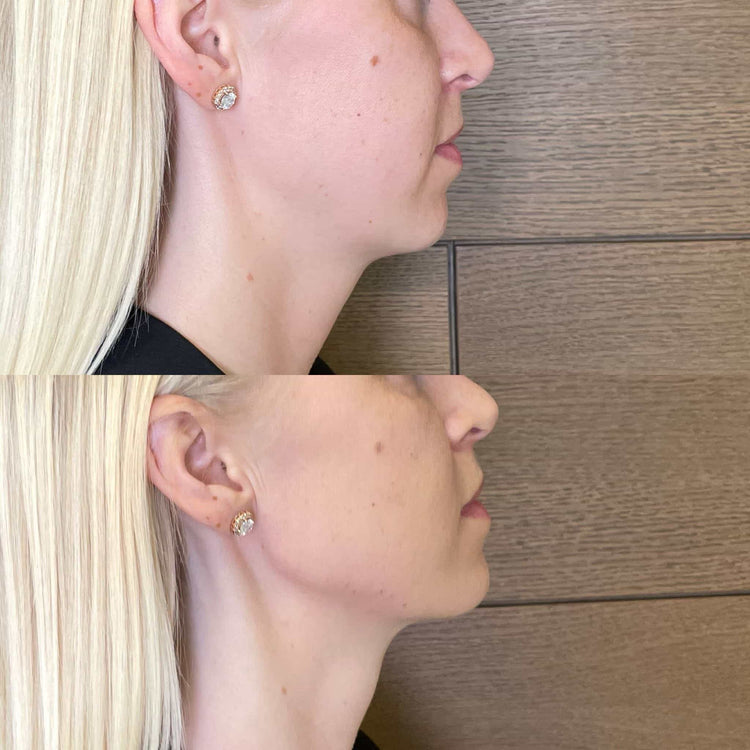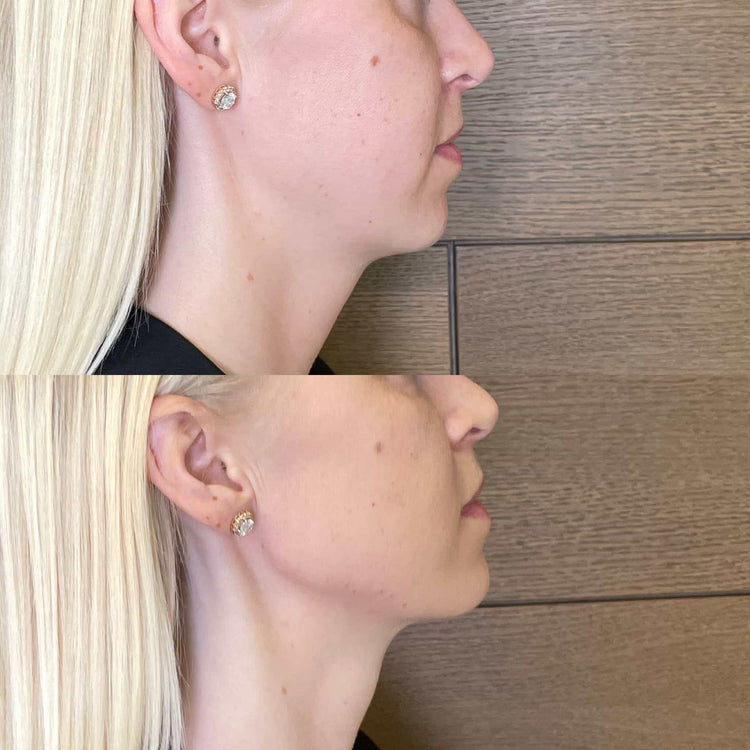The Science Behind Jaw Fillers: How They Work
Anatomy of the Jawline
The jawline, often lauded for its aesthetic appeal, is a complex structure formed by a combination of bone and soft tissue. Understanding the anatomy of this region is crucial for anyone considering jaw fillers.
Facial Muscles and Structure
The lower portion of the jawbone, known as the mandible, provides the bony framework for the jawline. Surrounding this bone are several muscles that contribute to facial expressions and chewing functions. Key players include the masseter (responsible for clenching), temporalis (assists with chewing), and platysma (contributing to frowning and lowering the mouth).
The skin overlying these structures is relatively thin, making it susceptible to changes in fat distribution and muscle tone over time. As we age, facial fat can gradually redistribute, leading to a less defined jawline and an appearance of sagging. Muscle weakening also contributes to this effect.
The Importance of Fat Distribution
The prominence of the jawline is significantly influenced by the distribution of subcutaneous fat. Fat pads located along the angle of the mandible and along the lower border of the cheekbones play a crucial role in shaping the jawline’s contour. As individuals age, these fat pads tend to decrease in volume, leading to a less defined and more rounded jawline.
Strategic placement of filler injections can counteract this natural loss of volume by restoring fullness to these key areas. By adding hyaluronic acid-based fillers, practitioners can sculpt the jawline, enhance its definition, and create a more youthful appearance.
Types of Jaw Fillers
Various types of jaw fillers exist, each with unique properties designed to address specific aesthetic concerns. Hyaluronic acid fillers are among the most popular choices, offering versatility in contouring and volumizing the jawline. Poly-L-lactic acid (PLLA) fillers stimulate collagen production for a more gradual and long-lasting enhancement. Calcium hydroxylapatite, another type of filler, is known for its firmness and ability to provide structural support.
Hyaluronic Acid Fillers

Hyaluronic acid (HA) is a naturally occurring substance found in the body that helps to keep skin hydrated and plump. HA fillers work by injecting this gel-like substance beneath the skin, adding volume to areas like the jawline.
Different HA fillers come with varying levels of consistency and longevity. Some are designed for immediate results and last several months, while others offer a longer-lasting effect, potentially up to two years.
Calcium Hydroxylapatite Fillers
Calcium hydroxylapatite (CaHA) is a biocompatible filler made from microscopic calcium phosphate crystals suspended in a gel-like carrier solution.
- These crystals bind with the body’s own collagen, providing a firm and long-lasting result.
- CaHA fillers are particularly effective for addressing volume loss and creating a more defined jawline. They offer a noticeable lift and contouring effect that can last for up to 18 months.
Poly-L-Lactic Acid (PLLA) Fillers
Poly-L-Lactic Acid (PLLA) fillers work differently than hyaluronic acid fillers. Instead of adding volume directly, they stimulate the body’s own collagen production.
PLLA is a biodegradable synthetic polymer that is gradually broken down by the body over time. As it degrades, it triggers the fibroblasts, cells responsible for producing collagen, to create new collagen fibers in the treated area.
This gradual collagen production leads to a more subtle and natural-looking enhancement of the jawline over several weeks or months. PLLA fillers are known for their long-lasting results, which can last up to two years or more.
How Jaw Fillers Work
Jaw fillers are injectable substances used to enhance the definition and prominence of the jawline.
Filling and Shaping the Jawline
Jaw fillers are injectable substances used to enhance the definition and prominence of the jawline. They work by adding volume to specific areas along the jawline, creating a more sculpted and defined appearance.
Various types of jaw fillers exist, each with unique properties designed to address specific aesthetic concerns. Hyaluronic acid fillers are among the most popular choices, offering versatility in contouring and volumizing the jawline.
Hyaluronic acid (HA) is a naturally occurring substance found in the body that helps to keep skin hydrated and plump. HA fillers work by injecting this gel-like substance beneath the skin, adding volume to areas like the jawline.
Different HA fillers come with varying levels of consistency and longevity. Some are designed for immediate results and last several months, while others offer a longer-lasting effect, potentially up to two years.
Calcium hydroxylapatite (CaHA) is a biocompatible filler made from microscopic calcium phosphate crystals suspended in a gel-like carrier solution.
- These crystals bind with the body’s own collagen, providing a firm and long-lasting result.
- CaHA fillers are particularly effective for addressing volume loss and creating a more defined jawline. They offer a noticeable lift and contouring effect that can last for up to 18 months.
Poly-L-Lactic Acid (PLLA) fillers work differently than hyaluronic acid fillers. Instead of adding volume directly, they stimulate the body’s own collagen production.
PLLA is a biodegradable synthetic polymer that is gradually broken down by the body over time. As it degrades, it triggers the fibroblasts, cells responsible for producing collagen, to create new collagen fibers in the treated area.
This gradual collagen production leads to a more subtle and natural-looking enhancement of the jawline over several weeks or months. PLLA fillers are known for their long-lasting results, which can last up to two years or more.
Stimulating Collagen Production
Jaw fillers work by introducing volumizing substances into specific areas along the jawline. These substances either directly add volume or stimulate the body’s own collagen production, leading to a more defined and prominent jawline.
Hyaluronic acid (HA) fillers are a common choice because HA is naturally found in the body and helps retain moisture. Injecting HA gel-like substance beneath the skin adds immediate volume to areas like the jawline.
Poly-L-lactic acid (PLLA), on the other hand, works differently. PLLA is a biodegradable synthetic polymer that stimulates collagen production over time. As PLLA degrades, it triggers fibroblasts (cells responsible for collagen production) to create new collagen fibers in the treated area.
This gradual collagen buildup leads to a more subtle and long-lasting enhancement of the jawline compared to immediate volume addition from HA fillers.
Benefits of Jaw Filler Treatments
Jaw fillers offer a non-surgical approach to enhance facial aesthetics by adding volume and definition to the jawline. These injectable substances work by either directly adding fullness or stimulating the body’s natural collagen production, resulting in a more sculpted and contoured appearance.
Enhanced Facial Contouring
Jaw filler treatments offer numerous benefits for those seeking to enhance their facial contouring. One primary advantage is the ability to create a more defined jawline, leading to a more sculpted and aesthetically pleasing profile. By adding volume to specific areas along the jaw, fillers can counteract age-related volume loss and restore a youthful appearance.
Moreover, jaw fillers can help improve facial balance by emphasizing the jawline in proportion to other facial features. They can also minimize the appearance of jowls and create a more lifted and contoured lower face.
Another benefit is the non-surgical nature of the procedure. Unlike surgical procedures, jaw filler treatments are relatively quick, minimally invasive, and typically require little to no downtime. They also carry fewer risks and complications compared to surgery.
Improved Facial Symmetry
Jaw fillers offer a non-surgical approach to enhance facial aesthetics by adding volume and definition to the jawline. These injectable substances work by either directly adding fullness or stimulating the body’s natural collagen production, resulting in a more sculpted and contoured appearance.
One major benefit is improved facial symmetry.
- Fillers can be strategically placed to even out asymmetries that may exist between both sides of the face.
- This creates a more balanced and harmonious appearance, enhancing overall facial proportions.
Reduction in Double Chin Appearance
Jaw fillers offer a non-surgical approach to enhance facial aesthetics by adding volume and definition to the jawline. These injectable substances work by either directly adding fullness or stimulating the body’s natural collagen production, resulting in a more sculpted and contoured appearance.
One major benefit is improved facial symmetry. Fillers can be strategically placed to even out asymmetries that may exist between both sides of the face. This creates a more balanced and harmonious appearance, enhancing overall facial proportions.
Another advantage is the reduction in the appearance of a double chin. By adding volume below the chin, fillers can create the illusion of a more defined jawline and minimize the appearance of excess fat or laxity in the submental area (the area under the chin).
Risks and Side Effects
While jaw fillers offer numerous aesthetic benefits, it’s important to be aware of potential risks and side effects. Like any medical procedure, filler injections carry some level of risk, and individuals may experience temporary or, in rare cases, more serious complications.
Swelling and Bruising
Swelling and bruising are common side effects of jaw filler treatments, typically appearing within a few days after the procedure. Most swelling subsides within a week or two, but some individuals may experience mild swelling for a longer duration. Bruising can also occur, often resolving within 10 to 14 days.
Other potential side effects include redness, tenderness, itching, and discomfort at the injection site. These symptoms are generally temporary and resolve within a few days to a week.
In rare cases, more serious complications can occur, such as infection, allergic reactions, or vascular occlusion (blockage of blood vessels). It’s crucial to choose a qualified and experienced practitioner who follows proper sterilization procedures and injection techniques to minimize the risk of these complications.
Infection
While jaw fillers offer numerous aesthetic benefits, it’s important to be aware of potential risks and side effects. Like any medical procedure, filler injections carry some level of risk, and individuals may experience temporary or, in rare cases, more serious complications.
Swelling and bruising are common side effects of jaw filler treatments, typically appearing within a few days after the procedure. Most swelling subsides within a week or two, but some individuals may experience mild swelling for a longer duration. Bruising can also occur, often resolving within 10 to 14 days.
Other potential side effects include redness, tenderness, itching, and discomfort at the injection site. These symptoms are generally temporary and resolve within a few days to a week.
In rare cases, more serious complications can occur, such as infection, allergic reactions, or vascular occlusion (blockage of blood vessels). It’s crucial to choose a qualified and experienced practitioner who follows proper sterilization procedures and injection techniques to minimize the risk of these complications.

Allergic Reactions

It is important to note that jaw fillers, like any medical procedure, carry potential risks and side effects. While generally safe, it’s crucial to be aware of these possibilities before undergoing treatment.
Common side effects are usually mild and temporary. These include swelling, bruising, redness, tenderness, itching, and discomfort at the injection site. Most individuals experience these reactions for a few days to a week and they typically subside on their own.
Less common, but more serious side effects can occur. These may include infection, allergic reactions, or vascular occlusion (a blood vessel blockage). It is vital to choose a qualified and experienced practitioner who adheres to strict sterilization protocols and proper injection techniques to minimize the risk of such complications.
Allergic reactions to filler substances are possible, although they are relatively rare. Individuals with known allergies to certain ingredients should inform their practitioner beforehand.
If you experience any unusual or persistent symptoms after a jaw filler treatment, it is essential to contact your practitioner immediately for proper evaluation and management.
- Profhilo In West Molesey, Surrey - November 11, 2025
- Why Does Temple Filler Hurt? - November 4, 2025
- What Is The Difference Between Non-Surgical Bum Fillers And PDO Threads? - November 3, 2025
